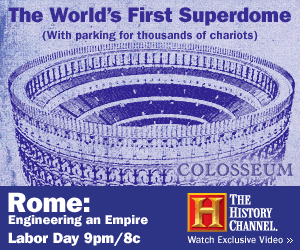About that other Superdome
Une pub d’une chaîne de télévision spécialisée dans l’histoire. Trouvée à côté d’un article sur l’aide aux victimes de l’inondation à La Nouvelle Orléans.
On peut s’interroger sur le bon goût, mais aussi sur la justesse historique pratiqués par The History Channel.
When I read the AFP wire US declines Swedish water sanitation aid on Yahoo! News#[1], the ad I’ve reproduced here was shown next to the article. (You’ll probably see a different ad if you click on the link; the original file is here (gif file).)

So what’s wrong with it?
- I don’t know how many other US sports stadiums are called “Superdome”#[2], but for the moment, the name calls to mind the New Orleans Superdome and its scenes of suffering.
- If the Colosseum (the German Wikipedia entry is actually quite a bit better, for once) was a “Superdome”, what went on there? Well, public entertainment, except that it was cheaper (free admission for Roman citizens, as opposed to the $90 ticket price I’ve seen quoted for the New Orleans football games): fights between animals (venationes), combats between gladiators (munera), public executions, in particular the killing of prisoners by animals (noxii). And mock naval battles (naumachiae) — in the beginning, the basement of the Colosseum could be flooded. Estimates vary, but several hundreds of thousands of people died there during these extremely blood-thirsty spectacles. The Colosseum is a contender for the top spot on the list of single places that saw the killing of the gratest number of human beings, in known history.
At this point I start seriously wondering what kind of association The History Channel is aiming for in its ad. - If the Colosseum, or Amphitheatrum Flavium, was the biggest Roman amphitheatre, it wasn’t the first such venue. It was inaugurated in 80 C.E., whereas the second largest, in Capua, was at least begun, if maybe not completed, in Augustan times (i.e. before 14 C.E.), and for the third largest, Verona’s Arena, usually a date of around 30 C.E. is given. Both seated tenths of thousands of people and were used for similar forms of entertainment, so they should qualify for the “Superdome” label.
Not to mention much older great amphitheatres, with their religious and properly theatrical festivals, - I find the reference to chariots puzzling. Either they are thinking of visitor parking — in which case they would be quite far off the mark. The masses of Rome certainly didn’t arrive in chariots. As for parking space outside the Colosseum, have a look at this scale model (the Colosseum is the near-circular shape at the top of the image, about two fifth in from the right edge). Imperial Rome was a crowded city of up to a million inhabitants. Not much consideration was given to chariot parking lots.
Or were they thinking of chariot races? Like in Ben Hur? Those didn’t take place in the Colosseum, but in the Circus Maximus, among other places. (In the image, the Circus Maximus is the oblong race track to the right of the Colosseum.)
I am unfamiliar with The History Channel and have no idea of its overall quality. This ad doesn’t precisely give me a favourable impression of its concern for historical accuracy, or good taste, for that matter.
[1]: Refusing water sanitation aid doesn’t strike me as a particularly bright idea, given the immense need. Still, the Swedish official who is quoted in the article leaves the question ultimately open: “They couldn’t accept the aid today (but) we’re still waiting for word that they may need our help.” (UPDATE — not to let this stand: a few hours after this was posted, news wire stories came in saying that the US is now indeed asking for help. Good. [2]: There’s a fair amount of confusion in the European media between “Superdome” and “Superbowl”. After all, a bowl is just a dome turned upside-down. The Colosseum, for what it’s worth, does look more like a bowl than a dome.
Billets connexes : Mon pin's est greenz, Minimalist Kitkat, Commercial ties, BBC "Word 4 Word", Branding: IPA and exotism, Interview with New Orleans mayor Ray Nagin, uncensored, Garden paths
Technorati (tags): advertising, Katrina, language, media, publicité, Rome, Superdome, Werbung


Badvertising
I saw this ad for the History Channel’s series on Rome on the back of a magazine: Since then I’ve seen it on a huge billboard here in New York. I guess this is what you call bad timing, since…
the romans are the greatest warriors since the greek so fuck you all!!!